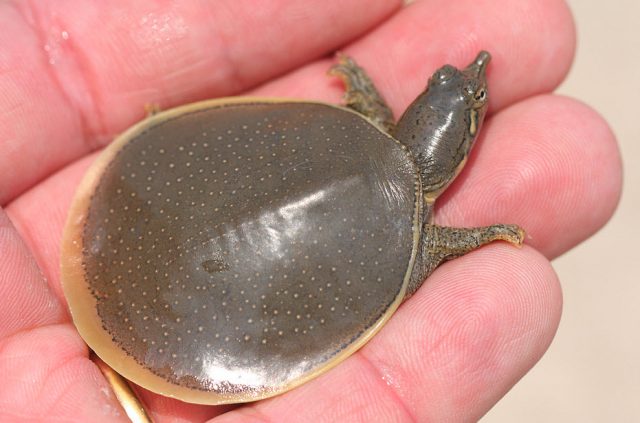05/12/2017 – Is that a Pancake in the River? (Karen Benson)

A baby Guadalupe Spiny Softshell is only about an inch and a half long upon hatching. These unusual turtles have no scutes on their shells; just a slightly sandpapery skin. The snout is long, tapered and angled upward so the turtle can be submerged and still have its nostrils above water. Jason Penney Photo.
Could that be a pancake just under the surface of Blanco Creek? It certainly looks like a pancake. It is round, about the size of a plate, and toasty-brown in color. It even has the yellowish-ivory edge of a nicely done flapjack! However, this “pancake” had four legs and long neck. It had to be a turtle of some sort. But, what kind was it?
For a long time, I thought there were only two kinds of turtles: sliders and snappers. Red-eared Sliders are the cute and classic pond turtle. Snapping turtles, particularly Alligator Snapping Turtles, are those large freshwater turtles with long tails and very short tempers. A big one could easily out-weigh a child. On land, they stand with “their hindquarters elevated and their mouth agape” and will strike repeatedly. We kids were warned: “You could lose a finger, or an arm, to one of those! Don’t mess with snapping turtles!”
This “pancake” turtle was not a snapping turtle. Nor was it a typical slider. For one thing, the top shell, or carapace, lacked those scale-like plates called scutes. The carapace looked smooth and soft. It looked like you could bend the edges a bit. Was this a soft-shelled turtle? Was there such a thing? Is a soft-shelled turtle like a soft-shelled crab, just a stage after molting? No, wait, turtles cannot molt their shells; the shells are part of the animal’s skeleton. Obviously, I needed to do some reading about such turtles.
Soft-shelled turtles are reptiles, like all turtles. However, unlike other turtles, they do not have scutes on their shells. The carapace is rubbery and flexible. Soft-shelled turtles have smooth, sandpapery, or spiny skin on their backs. There are six species of soft-shells in North America. They are distinguished by the texture and patterning on their shells, by their nostrils, and by their ranges.
The Smooth Soft-shelled Turtles have no spines, bumps, or sandpapery projections on their carapaces. Their nostrils are perfectly round with no ridges on the inside. The nostrils of all the other kinds of softshells have an inner ridge. You might actually notice this feature since the soft-shelled turtles often bask underwater with just their long Pinocchio-like noses sticking out. Smooth Soft-Shelled Turtles inhabit the Mississippi River and its tributaries.
The Florida Softshell has bumps on its shell. The bumps are flattened hemispheric projections-but not cones or spines-along the front edge of the carapace. This species is primarily a lake dwelling turtle. Its range extends throughout Florida, southern Georgia and Alabama.
The Spiny Softshells have the widest range, from the Great Lakes to Mexico. There are even some western populations. In our particular part of Texas, we are most likely to find the Guadalupe Spiny Softshell. It is the least spiny of the Spiny Softshells, having more of a sandpapery texture to its shell. The Guadalupe Spiny Softshell species is actually a complex of three subspecies “that are characterized by small white spots on the brown or olive carapace.” The Guadalupe subspecies is restricted to drainage systems of the Guadalupe-San Antonio and Nueces Rivers. Another subspecies is a river turtle in the north and eastern parts of Texas. The subspecies known as the Texas Spiny Softshell occupies the Rio Grande-Pecos River drainages and rivers in northern Mexico.
If you think of turtles as slow and lumbering, you need to think again about Soft-shelled Turtles. These “animated pancakes belie the traditional slowness of the turtle.” Try to grab one in the water and it will swim away in a heartbeat. Even on land, they are surprisingly speedy and agile. If you do happen to catch one, handle it with caution. They have sharp claws and hard-edged jaws. Treat softshells with the respect due a snapper!
The Guadalupe Spiny Softshell is quite at home in the rivers of south-central Texas. Open sections of waterways with some vegetation and muddy bottoms are ideal for these turtles. Since they can get oxygen through their skins, softshells often burrow into the mud for the winter months. They rouse themselves in spring to feed on shrimp, minnows, and small invertebrates. For basking and nesting, they need a warm, sunny sandbar. The females dig a hole in the moist sand to lay their eggs. It takes two or three months for the eggs to hatch, during which time the nests are vulnerable to raccoon and skunk predation. If the young make it to hatching, they (as well as the adults) are prey for alligators. Fortunately, once out of the egg, Guadalupe Spiny Softshells are fast and agile. With luck, they can avoid becoming the alligator’s dinner.
So, if you get a chance to canoe or kayak on a river in south Texas this summer, watch for “pancakes” in the water. You just might get a chance to see these unusual Spiny Soft-shelled Turtles in their native habitat.
